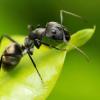Twentynine Palms, CA, USA
7/24/2019
Body:
1. Location of collection: Desert field, Twentynine Palms, CA, USA. I found 6 of them, 5 were within 1 foot of the street as I walked along the curb and I found 1 more about 15 feet in from the street.
2. Date of collection: 7/23/2019, at about 9:00pm.
3. Habitat of collection: It was a vacant piece of land in the desert along a wash. There was desert type of plants, but not dense. This piece of land was a long thin strip that ran between the wash and a house. She was found about 20 feet from the road.
4. Length: 11mm to 12mm.
5. Coloration, hue, pattern and texture: The color of honey, with some faded light brown bands across her gaster as well as her back.
6. Distinguishing characteristics: Three small spots on her head, seems like a pretty large eye. They are fast on the ground and when climbing the walls of the container.
7. Anything else distinctive: None that I could tell.
8. Nest description: Unknown
9. Nuptial flight time and date: Unknown.



















